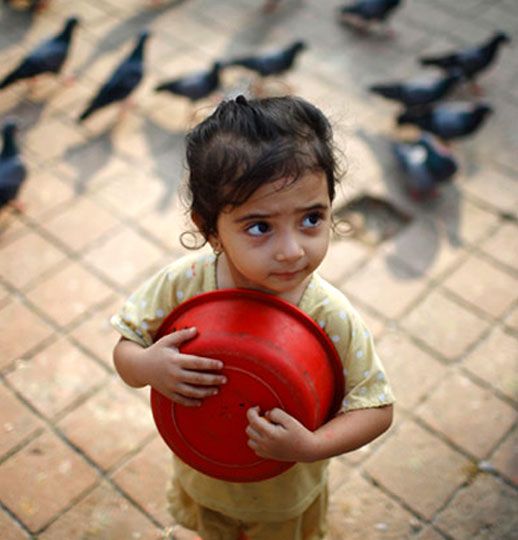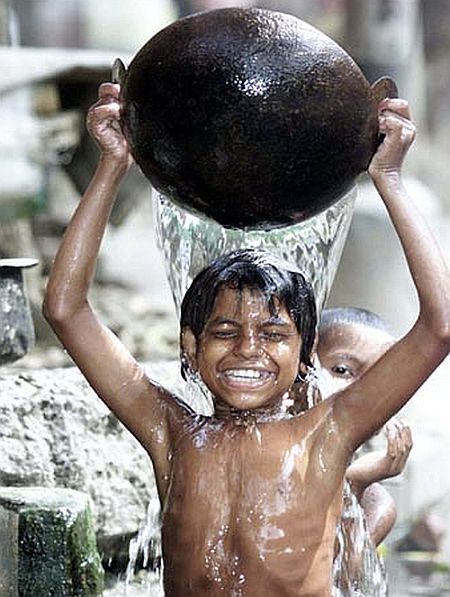 | « Back to article | Print this article |
India must take steps to eradicate extreme poverty and hunger, says Subir Gokarn.

In 2000, the United Nations held a Millennium Summit, at which the membership adopted the Millennium Development Goals (MDGs).
Spanning a range of development indicators - poverty, gender, health, education and the environment - the MDGs essentially established a set of targets for the global community to achieve by 2015.
The framework sets eight broad goals in relation to these domains. In its latest version, these are quantified in terms of 21 targets, which, in turn, are represented by 60 indicators.
As we approach that deadline, governments and development agencies are in stocktaking mode, looking at which goals were met and which weren't.
There is already a conversation emerging around goals and strategies beyond 2015. The Union ministry of statistics and programme implementation recently published its Statistical Yearbook for 2014.
One chapter is dedicated to the country's achievements on the eight goals for next year, tracking them in terms of relevant indicators.

Image: Rinku, 20 months, who weighs 4 kg and suffers from severe malnutrition, lies in his mother's lap in Naingarh village of Sheopur district in Madhya Pradesh. Photograph: Reinhard Krause/Reuters
Goal one is eradicating extreme poverty and hunger.
For India, notwithstanding its conceptual and measurement limitations, the poverty ratio - the percentage of people below the poverty line - is the most practical measure.
The target here is to halve the poverty ratio (defined as those who live on less than one dollar a day) between 1990 and 2015.
Going by the most recent estimates, based on the 2011-12 household expenditure survey, this target is well within reach, or "on track" as the yearbook classifies it.
However, the other target related to this goal, halve the number of people who suffer from hunger over the same period, is assessed to be "slow or almost off track".
This provides an important backdrop to the current debate on food security and how best to achieve it, in terms of targeting, delivery and cost.
Goal two is to achieve universal primary education. This is judged to be "on track", the main indicator being primary school enrolment. Recent estimates put this number at above 90 per cent.

Clearly, almost all young Indians are getting to school, though there are widespread concerns about the quality of the education they are receiving.
Quality enhancement would certainly be an appropriate target for beyond 2015; meanwhile, the system can take some credit for near-universal primary enrolment.
However, the story changes dramatically beyond this phase, when enrolment drops by about a third in the secondary phase.
This magnitude of exit from the school system at the end of the primary stage is a threat to the fundamental aspiration of inclusive and equitable growth.
Its causes need to be clearly understood for a meaningful policy response to be designed.
Goal three is to eliminate gender disparities at all levels of education. This is assessed to be "on track" for primary and secondary education, but "slow" for higher education.
Notwithstanding what the numbers say, observation suggests that there is a significant degree of variation across the country in these indicators.
The implication for a robust national solution, then, is that region or state-specific responses that are customised to local conditions need to be put in place.

Goal four is to reduce child mortality, with the target of reducing the under-five mortality rate by two-thirds between 1995 and 2015. This is assessed to be "moderately on track".
One could argue that the target itself is quite ambitious, so difficult to attain.
On the other hand, it reflects a disturbing inability of the healthcare system to reach its most vulnerable constituency.
Preventive factors like nutrition and sanitation also play a significant role in reducing child mortality, so we need to think more holistically about combining different components into an effective package.
Goal five is to improve maternal health, with a target similar to that of goal four: a two-thirds reduction in the mortality rate between 1990 and 2015. This target is, disappointingly, assessed to be "slow or off track".
As in the case of child mortality, improvements on this indicator will depend on the complementarities between healthcare, nutrition and sanitation being effectively used.
Why the system is lagging on this goal relative to child mortality is an obvious concern and perhaps warrants a diagnosis from the broader perspective of gender disparities.
Goal six is to combat HIV/AIDS, malaria and other diseases. On HIV/AIDS, the target is to have halted and begun to reverse its incidence by 2015.

This is seen as being "on track", reflecting the relative success of a very focused approach to prevention and control, emphasising behavioural changes among highly vulnerable groups.
Epidemiological patterns may also have something to do with this plateauing, but this should not detract from the effectiveness of the policy response.
In contrast, the assessment of progress on malaria and other major diseases is that it is "moderately on track".
These diseases have a larger environmental than a behavioural nature and are, therefore, more dependent on co-ordinated responses.
No surprises, then, on the weaker achievement.
Goal seven is to ensure environmental sustainability. One target is to integrate principles of sustainability into country policies and programmes.
This is assessed to be "moderately on track". But it is important to point out that there is a great distance between intent and practice, which is really what matters here.

On the more tangible target of halving the number of people without access to safe drinking water and basic sanitation between 1990 and 2015, the assessment is that access to water is "on track or fast", while for sanitation it is "slow".
This may well be an underlying cause of the relatively uneven progress on a variety of indicators.
It certainly has to be a huge factor in any quality-of-life assessments.
Finally, goal eight is to develop a global partnership for development.
The target is to partner with the private sector to make available the benefits of technology, particularly information and communication.
Obviously, there is no clear metric for this, but casual observation suggests a huge surge in private involvement in the development process through a range of organisational and financial structures.
Of course, this energy needs to be channelised and aligned for maximum effect, for which a policy framework might be useful.
To sum up: half-full, half-empty on the MDGs in India. But the assessment gives the government a good sense of the priorities beyond 2015.